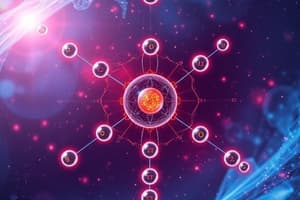Podcast
Questions and Answers
What determines the valence of an element?
What determines the valence of an element?
Which type of chemical bond is formed when atoms share a pair of electrons?
Which type of chemical bond is formed when atoms share a pair of electrons?
In ionic compounds, which group of elements is most likely to form cations?
In ionic compounds, which group of elements is most likely to form cations?
What happens to the size of an anion compared to its parent atom?
What happens to the size of an anion compared to its parent atom?
Signup and view all the answers
What is the term used to describe an atom that has lost electron(s)?
What is the term used to describe an atom that has lost electron(s)?
Signup and view all the answers
What type of state has higher energy than the ground state of an atom or molecule?
What type of state has higher energy than the ground state of an atom or molecule?
Signup and view all the answers
Which quantum number describes the size of orbitals and the relative distance of electrons from the nucleus?
Which quantum number describes the size of orbitals and the relative distance of electrons from the nucleus?
Signup and view all the answers
Which quantum number refers to the shape of the orbitals in an atom?
Which quantum number refers to the shape of the orbitals in an atom?
Signup and view all the answers
According to Pauli's exclusion principle, how many electrons can occupy an orbital?
According to Pauli's exclusion principle, how many electrons can occupy an orbital?
Signup and view all the answers
What rule states that electrons must distribute singly before pairing in orbitals?
What rule states that electrons must distribute singly before pairing in orbitals?
Signup and view all the answers
What is the lowest energy state of an atom called?
What is the lowest energy state of an atom called?
Signup and view all the answers
How does the orbital size change with increasing n-value?
How does the orbital size change with increasing n-value?
Signup and view all the answers
What did Woehler achieve by synthesizing urea from ammonium cyanate in 1828?
What did Woehler achieve by synthesizing urea from ammonium cyanate in 1828?
Signup and view all the answers
Which scientist is known for noting that organic compounds always contain the element carbon?
Which scientist is known for noting that organic compounds always contain the element carbon?
Signup and view all the answers
What did Kekule and Couper demonstrate in 1858 that led to the concept of catenation?
What did Kekule and Couper demonstrate in 1858 that led to the concept of catenation?
Signup and view all the answers
Why do organic compounds generally have low melting and boiling points compared to ionic compounds?
Why do organic compounds generally have low melting and boiling points compared to ionic compounds?
Signup and view all the answers
What characteristic makes organic compounds nonpolar in nature?
What characteristic makes organic compounds nonpolar in nature?
Signup and view all the answers
Why do organic compounds react slower than ionic compounds?
Why do organic compounds react slower than ionic compounds?
Signup and view all the answers
What is the main reason atoms share their valence electrons?
What is the main reason atoms share their valence electrons?
Signup and view all the answers
Which type of bonding involves the sharing of electrons between atoms?
Which type of bonding involves the sharing of electrons between atoms?
Signup and view all the answers
In which type of covalent bond is there a partial positive and partial negative charge along the bond?
In which type of covalent bond is there a partial positive and partial negative charge along the bond?
Signup and view all the answers
Which type of bond results from equal or almost equal sharing of electrons?
Which type of bond results from equal or almost equal sharing of electrons?
Signup and view all the answers
When does ionic bonding occur between atoms?
When does ionic bonding occur between atoms?
Signup and view all the answers
Which kind of covalent bond has the least difference in electronegativity values between combining atoms?
Which kind of covalent bond has the least difference in electronegativity values between combining atoms?
Signup and view all the answers
What is the role of electrons in thermal conductivity?
What is the role of electrons in thermal conductivity?
Signup and view all the answers
In a neutral atom, what is the relationship between the number of protons and electrons?
In a neutral atom, what is the relationship between the number of protons and electrons?
Signup and view all the answers
What does the atomic number (Z) represent in an atom?
What does the atomic number (Z) represent in an atom?
Signup and view all the answers
How is the mass number (A) calculated?
How is the mass number (A) calculated?
Signup and view all the answers
What is the maximum number of electrons that can be accommodated in an orbital?
What is the maximum number of electrons that can be accommodated in an orbital?
Signup and view all the answers
How do electron shells affect the chemical properties of an element?
How do electron shells affect the chemical properties of an element?
Signup and view all the answers




